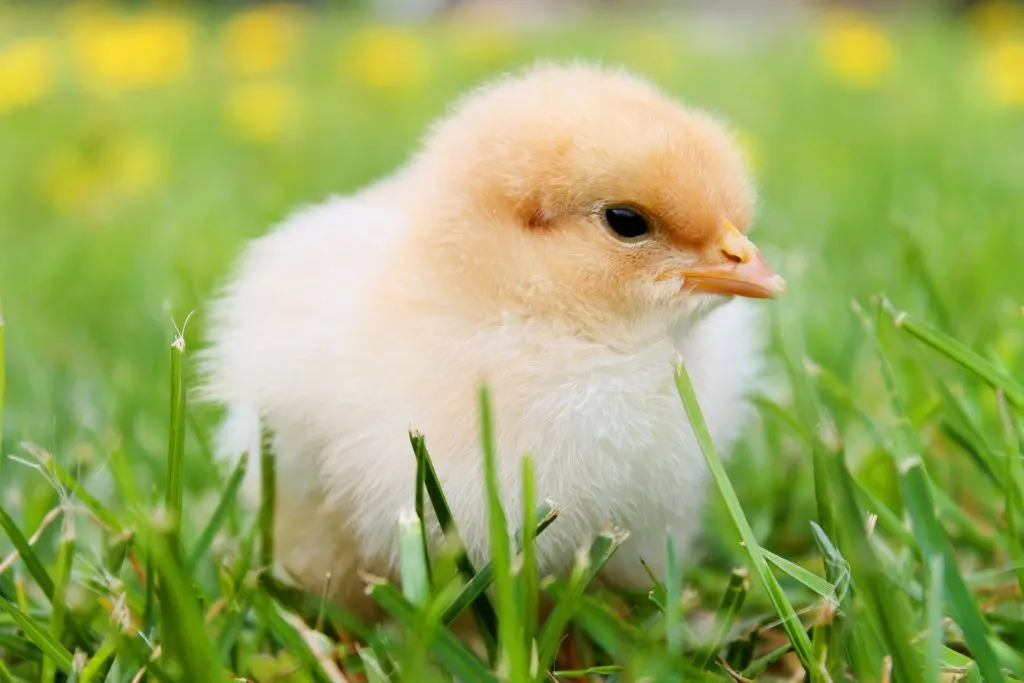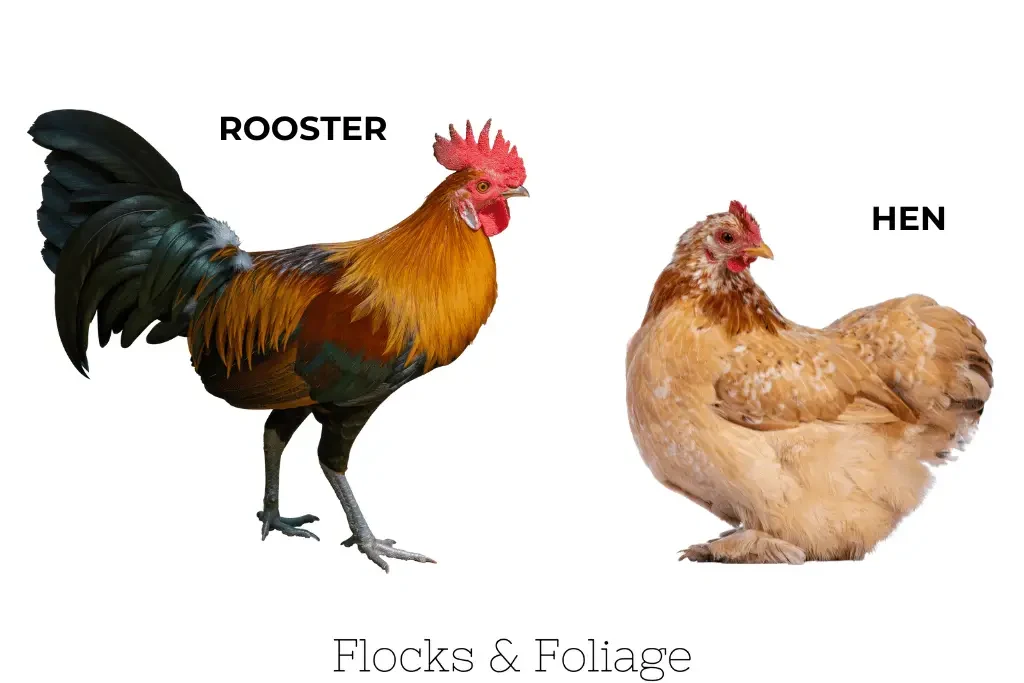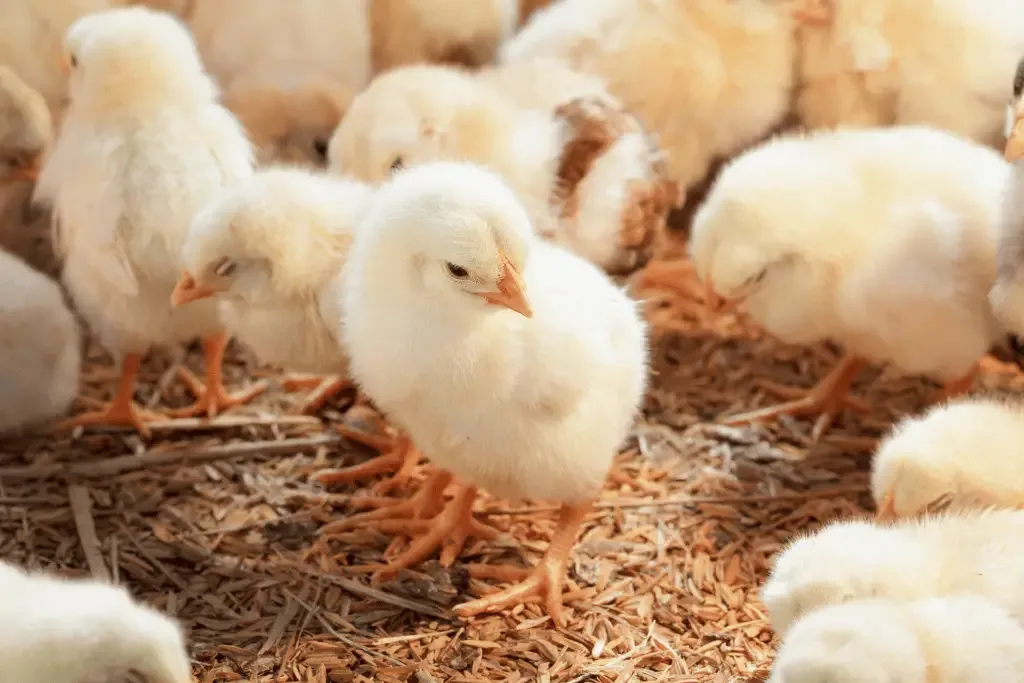Determining the sex of a chicken can be a challenge, especially for beginner chicken owners.
However, it is an essential skill to have if you want to keep a flock of chickens.
There are several methods that can be used to sex chickens.
Each method has its advantages and disadvantages, and some are more accurate than others.
In this article, we will discuss:
- The different methods of how to sex chickens
- Details on each method
- Ways that you can’t sex a chicken
- And some frequently asked questions

Understanding Chicken Sexing
In this section, we will discuss the importance of chicken sexing and an overview of the methods used when doing so.
The Importance of Chicken Sexing
Chicken sexing is a crucial aspect of poultry farming.
It involves identifying the sex of a chicken, which is important for many different reasons.
For instance, farmers and some homesteaders need to separate male and female chickens to manage their population and prevent inbreeding.
Also, some chicken breeds are better suited for egg production, while others are better for meat production and therefore, farmers need to know the sex of their chickens to determine which ones to keep and which ones to cull.
Methods Used in Chicken Sexing
There are several methods used in chicken sexing, including visual sexing, vent sexing, feather sexing, and DNA sexing.
- Visual sexing involves examining the physical characteristics of a chicken, such as its comb, wattles, and size
- Vent sexing involves examining the chicken’s vent, which is the opening for the reproductive and excretory systems
- Feather sexing involves examining the feathers of a chicken, specifically the hackle and saddle feathers
- DNA sexing involves taking a DNA sample from the chick to analyze and determine it’s gender
Farmers must be careful when sexing chickens, as mistakes can lead to the culling of valuable birds or the introduction of unwanted traits into the flock.
Therefore, it is essential to use accurate and reliable methods and to seek the advice of experts when necessary.

Vent Sexing
Vent sexing is a popular method of sexing chickens, especially for commercial hatcheries.
It is one of the most accurate ways to differentiate male chicks from female chicks.
However, it requires a lot of skill and experience to do it correctly.
How to Vent Sex Chick
Venting works best when the chick is one to two days old.
Older chickens are more difficult to sex accurately, and the process can be stressful for the birds.
It is also important to note that some breeds are inherently difficult to sex, resulting in less accuracy.
Bantams are rarely vent-sexed because they are so small and delicate that they may be injured in the process.
The process for vent sexing includes:
- Take a day-old chick and turn them upside down
- Gently push down just below the chick’s vent to spread it open (the vent area is turned outward in the process)
- Examine the vent area and look for the presence or absence of a rudimentary male sex organ to determine if the chick is male or female
Keep in mind that while vent sexing is the most dependable way to sex a chicken, it is recommended that the average chicken keeper ask a professional to do this for them.
The process of vent sexing can go wrong in a few different ways.
For instance, if the vent is pressed too hard or in the wrong spot, it can cause permanent damage to the chick and can even kill them in some circumstances.
The video below shows the process of vent sexing a chick.
Pros and Cons of Vent Sexing
The accuracy rate of a professional vent sexer is 95 to 98 percent.
This makes it a popular method for commercial hatcheries.
However, it is also quite difficult and takes someone with a lot of skill to do it correctly.
The process can be stressful for the birds and may result in injury if not done properly.
Vent sexing is also not a foolproof method of sexing chickens.
There is always the possibility of misidentification, especially with younger birds.
It is important to keep in mind that vent sexing is just one of several methods of sexing chickens, and it may not be the best method for everyone.
Feather Sexing
Feather sexing, or wing sexing, is a method of determining the sex of a chicken based on the length and shape of its wing feathers.
This method is commonly used in commercial hatcheries and is considered to be accurate, although it requires some skill and experience to perform correctly.
How to Feather Sex a Chick
Just like with vent sexing, feather sexing a chick works best when the chick is one to two days old.
To feather sex a chicken, follow this process:
- The chick’s wing must be gently pulled out and spread carefully
- Hold the chick’s body in one hand and extend the wing with the other hand
- The feathers on the wing should be separated and visible
In females, the primary feathers on the wing are longer than the secondary feathers, and there is a noticeable space between the two sets of feathers.
In males, the primary and secondary feathers are roughly the same length, and there is no noticeable space between them.
Feather sexing is a fairly dependable way to sex a chicken, however it’s also important to be very careful while using this method.
For instance, if the chick’s wing is pulled out too forcefully, it can potentially damage the wing beyond repair.
Pros and Cons of Feather Sexing
One advantage of feather sexing is that it can be done at a very young age, usually within the first few days after hatching.
This allows for early separation of males and females, which is important in commercial hatcheries where males are not needed and can be culled.
However, feather sexing requires some skill and experience to perform correctly, and mistakes can be made.
If done too aggressively, feather sexing can damage the chick’s wing permanently.
Additionally, this method is limited to certain breeds and crosses, and may not be accurate for all types of chickens.
DNA Sexing
DNA sexing is a reliable and accurate method of determining the sex of chickens.
It involves analyzing the DNA of the bird to identify its sex.
This method is especially useful for breeders who need to know the sex of their birds at a young age.
How to DNA Sex a Chick
The procedure of DNA sexing involves extracting DNA from the bird and analyzing it using PCR (polymerase chain reaction).
Their DNA is usually extracted from the basal part of chicken feathers, which takes around 30 minutes.
The PCR procedure takes approximately 70 minutes for 100 birds and the accuracy of DNA sexing is dependent on the quality of the DNA sample.
Therefore, it is crucial to ensure that the sample is collected correctly and stored properly.
The sex of the bird is determined by identifying specific genes on the DNA that are associated with either male or female characteristics.
Pros and Cons of DNA Sexing
One of the main advantages of DNA sexing is its accuracy.
It is a reliable method of determining the sex of birds, especially at a young age.
This can be beneficial for breeders who need to plan their breeding programs and manage their flocks more effectively.
Another advantage of DNA sexing is that it is non-invasive.
Unlike other methods of sexing, such as vent sexing, DNA sexing does not require physical contact with the bird.
This can be less stressful for the bird and reduce the risk of injury.
However, DNA sexing can be more expensive than other methods of sexing and is not a great option for the average chicken keeper or small homesteader.
It requires specialized equipment and expertise to perform the analysis.
Additionally, the time required to extract and analyze the DNA can be a disadvantage for breeders who need to sex large numbers of birds quickly.
Comb & Wattle Sexing
You can also sometimes tell the gender of a chick by examining its comb and wattles.
This method involves watching the bird closely as it grows to determine the gender of the bird.
How to Sex a Chicken Using Comb & Wattle Method
Sexing a chick based on its comb is a method that requires you to watch as the chick grows.
After the chick grows to around 2-4 weeks old, its comb becomes more apparent.
Male chicks typically have taller, fuller combs on the tops of their heads.
Male combs are also usually a lot brighter than female combs regardless of the color.
You can also sometimes sex a chick based on their wattles.
Male wattles typically grow faster and longer than female wattles.
Like the combs, male wattles are also brighter than female wattles.
Pros and Cons of Comb & Wattle Sexing
One pro of sexing based on a chick’s comb and wattle is that it is a less-invasive option compared to some others.
This is also a much easier method that can be done by any average chicken keeper or homesteader.
The downside is, this method can take a bit longer to determine the sex as you need to wait a few weeks to watch as the chick grows.
Comb and wattle sexing are also less accurate.
It can often be difficult to determine the gender solely based on the chick’s comb or wattle.
Colors and sizes can vary depending on the breed of chicken.
This method also doesn’t work well with certain breeds of chickens. Only chicken breeds with normal combs can be sexed using this method.
Listen to Hear if They Crow
One of the easiest and non-invasive ways to sex a chick is to listen to see if it crows.
Some people believe that a rooster only crows when it is fully mature and actually looks like a rooster. And while most of the time, this is true, there are some cases that a rooster will start crowing before you can visibly tell it’s a rooster.
Most roosters will start crowing at around 4 months of age but some can crow as soon as a month old.
Pros and Cons of This Method
Waiting to see if a chicken crows or not can be one of the most non-invasive ways to sex a chicken.
However, one major downside is it isn’t always accurate.
This method also takes much, much longer than some others as the rooster needs to mature several months before they start crowing.
And by that point, you can usually visibly tell what the gender of the chicken is just by looking at it.

Behavior Sexing
Another non-invasive way to determine the gender of a chicken is to watch their behavior.
As chicks mature, there are typically characteristics that determine what gender of chicken you have.
For instance, if a chick is more aggressive or more prone to fighting at an early age, there is a strong chance that the chick is a male.
Female chicks tend to be more docile and mild-tempered.
Male chicks tend to show more aggressive behaviors such as pecking, bumping other chicks with their chest, and excessive amounts of energy.
Pros and Cons of Behavior Sexing
While this method is extremely non-invasive, it can be incredibly inaccurate.
For instance, each chicken has its own personality and not all males and females have the same behavioral characteristics.
This method is also strongly based on watching the chick for a specific period of time and chicks do not maintain the same behaviors for all parts of the day.
For instance, you may catch a male that is tired and acting more docile or a female who gets a burst of energy and starts running around the coop.
Take into account that different breeds will also have different personalities and behaviors.
Auto-Sexing Chickens
Hatching and raising auto-sexing chickens is one way of telling the gender of your chicks without having to guess.
Autosexing chickens are purebred chickens that have very distinct feather colors and patterns at the time of hatching.
For instance, breeds like the Cream Legbar, Barred Plymouth Rock, and other sex-link chicken breeds all have specific feather colors when they hatch that clearly determine their gender.
It is important to note that you can only sex a chicken with autosexing chicks if they are purebred.
Hybrid chickens will not have the same color patterns at the time of hatching.

Ways You CAN’T Sex a Chicken
There are a number of different myths that give chicken keepers other options on how to identify the gender of their chickens.
Not only are these wives’ tales not accurate, but some can injure your chickens.
Some of these sexing myths include:
Egg Shape
It has been said for years that you can tell a chick’s gender based on the shape of the egg before it hatches.
They say if an egg is more rounded, it contains a female and if the egg is narrow and has a distinct pointed end, it contains a male.
This myth of sexing a chick is completely inaccurate and has not proven to be reliable whatsoever.
Candling
Another wive’s tale states that you can sex a chick by candling the egg before it hatches.
It is said that if the air sac inside the shell is located towards the blunt end of the egg, the chick will be a male and if it’s towards the side of the egg, the chick will be a female.
Again, this method is a complete myth and there is no scientific data that states it is accurate.
Turning Your Chick Upside Down
Turning your chicks upside down to see how they react is another false method of sexing your chicks.
It is said that if you tip a chick upside down, females will stay upside down and hang limply while the males will fight to try and stay upright.
Not only is this method inaccurate, but it can also severely injure your chicks.
There is no data that proves this is an accurate method and it is not worth the risk of hurting your chicks to try.
Egg Float Test
The last myth to determining the gender of your chicks is putting the eggs in water to see which ones float.
They say if the egg floats, the chick will be female and if it stays at the bottom, the chick is a male.
This method does not have any scientific proof that it works and you can actually end up killing the chick inside the egg by doing this.
There is however a well-known egg float test but it has nothing to do with sexing a chick.
The real float test requires you to put an egg in water and if it:
- Sinks to the bottom and lays flat, it is fresh to eat
- Sinks to the bottom but stands up vertically, it is still safe to eat but in the process of going bad
- Floats to the top, it should be discarded as the egg is most likely bad
The float test should only be used to determine how fresh the egg is for eating and nothing else.

The Role of a Professional Chicken Sexer
A professional chicken sexer is responsible for identifying the gender of recently hatched chicks with precision.
This task is critical in commercial poultry operations as the demand for male and female chickens can differ significantly due to variations in growth rates, egg-laying capabilities, and meat quality.
The primary role of a chicken sexer is to accurately identify and separate male and female chicks shortly after hatching.
They use their expertise to carefully observe and analyze distinct physical traits of the chicks to distinguish between males and females.
Professional chicken sexers are highly trained and skilled individuals who possess a keen eye for detail.
They must be able to work quickly and efficiently, as they are often required to sort through large numbers of chicks in a short amount of time.
In addition to their primary role, chicken sexers may also be responsible for other tasks such as record-keeping and maintaining equipment.
They must be able to work effectively as part of a team, as well as independently.
Final Thoughts
Overall, sexing chickens is an important task for those who raise poultry, whether for meat or eggs.
While it can be challenging to determine the gender of a chicken, there are several methods available, each with its own advantages and disadvantages.
The accuracy of sexing methods can vary depending on the skill of the person performing the task and the quality of the parent stock.
There are also a few sexing myths that should be avoided at all costs.
It is also important to remember that no method is 100% accurate and some are safer than others.
FAQs
How do you tell if a chicken is female or male?
There are a few different methods of sexing a chick such as vent sexing, feather sexing, DNA sexing, comb & wattle sexing, and behavioral sexing.
No method is 100% accurate and there are pros and cons to each method.
Each of these methods can typically be done when the chick is around 1-2 days old.
What is auto-sexing and how does it work?
Autosexing breeds are purebred chickens that have distinct color patterns and feathers at the time of hatching.
You can almost always tell the gender of the chicks right away after hatching autosexing chicks.
Can you sex bantam chickens using the same methods as standard chickens?
It can be more difficult to sex bantam chicks.
However, most of the methods used to sex standard chickens can also be used to sex bantam sized chickens.
Is it possible to sex chicken eggs before they hatch?
No, it is not possible to sex chicken eggs before they hatch.
There are some old wive’s tales that state you can but these methods are not accurate and have no scientific data to back up their claims.
Where can you find sexed chickens for sale?
You can most likely find some sexed chicks at your local hatchery or your local rural lifestyle retailer store.
Some may also be available at a number of different online hatcheries.
It’s important to do your research to ensure you are buying healthy birds from well-known, trusted hatcheries.

